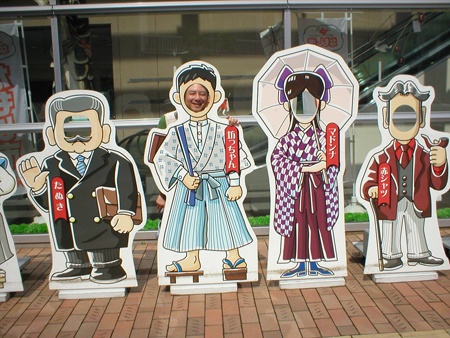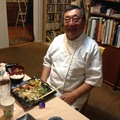Walking Tall in Japan
At 6 feet 1 inches tall (185 cm in metric, the accepted system in Japan and the rest of the civilized world), I often felt like a bit of an oddity walking around the streets and country sides of Japan. Some people would look, others would stare with curious smiles, trying to figure out where in the world I came from. The Japanese, we’ve learned, can tell a foreigner from the way we walk, dress and of course, if we open our mouths, the way we talk. We also have a different “air” about us. Even butt naked at a Beppu ryokan public bath, one Japanese woman told my mom she could tell that she wasn’t from Japan.
In thinking about this, we JAs can tell a Japanese from Japan when we see them in the States for the very same reasons listed above. On both sides, we just know. Perhaps it is in the “air.”
As for me, being over 6 feet is definitely a potential hazard. In our relative's house in Yoshida (a country suburb of Hiroshima), the hazards were all over the place and I found myself keeping my hand above my head so I’d know where and when I needed to duck (which was mainly in doorways and entrances to the living room, where we slept on tatami floors.) For the most part, I avoided banging my head with the one exception being that local bus in Fukuoka!
Japanese Toilets
At our relative's house, they have a toilet with a panel on the wall with buttons you push that automatically open and close the lid, buttons to flush, buttons to spray and a button for bidet. This was a pretty fancy model, not seen in most public places around Japan.
Toto, the Japanese maker of toilets, seems to be the industry leader with a variety of toilet types seen all over Japan. We opted for the standard Western variety whenever possible.
The Japanese, however, prefer the “squat” variety, due to their obsession with cleanliness and sanitary conditions. The squat toilet can pose a definite challenge if you’re not used to it. I definitely like the Western style, with the “Oshiri Spray.” It’s a strange sensation at first spray but the jet of warm water is quite nice once you get used to it. Okay, enough info on that!
Public bathrooms in Japan do not provide paper towels (as a way to save paper and waste) so it’s best to have a handkerchief handy to dry your hands after use.
English Speakers
Most Japanese study English in school, but I found that the majority of service staff in hotels, train stations, stores and restaurants, have limited to no ability to communicate to foreigners in English. My mom and dad, who were partly there to serve as my interpreters, helped me communicate with the service staff, although sometimes my dad, who has trouble hearing these days, couldn’t hear what was being said leaving us both lost in translation! Other times, I was out on my own and had to decide if I was going to speak in English, or my limited ability to speak in Japanese. Sometimes, I would ask if there was anyone on staff who could speak in English, and the Japanese staff were very good about rushing around to find the appropriate person. If there was no one there to speak in English, which was frequently the case in Kyushu, I would then struggle with my fragmented, bad Japanese. But I found that if they could pick up a word or two they would be able to understand what I was asking for. Of course, I couldn’t understand what they would say to me in response. A lot of times, if they didn’t have a particular item, they would cross their arms across their chest in the shape of an X, which, in Japan and other places around the world, is the symbol for something negative as in “We don’t have that item,” or you can’t go there, you can’t smoke there, you can’t take photos there, etc., all marked with a red “X” marked through it.
If you go to Japan, it’s best if you know some basic things to say in Japanese. “Sumimasen,” (Excuse me) and “Arigato gozaimasu.” (Thank you) are used quite frequently. I realized I need to learn a whole lot more!
H1N1 Virus Scare
We left for Japan knowing that there were growing numbers of people coming down with the H1N1 flu, especially among students in the Osaka/Kobe area. Thousands of local schools were shut down. Events were being canceled. Since we were flying from San Francisco to Osaka’s Kansai Airport, we didn’t know exactly what to expect upon arrival.
As we waited at SFO for our flight, we began to notice several people (mostly Japanese and other Asian nationals) wearing protective masks across their noses and mouths. I later learned that this is done to protect themselves and others from dangerous germs and viruses. The majority of Americans, I noticed, weren’t wearing the masks. Perhaps this is a foreign concept to us here?
During our flight on United Airlines, we were informed that everyone needed to fill out a medical form, which asked about any recent medical problems, if we had a fever or any flu-like symptoms and contact numbers for everywhere we were staying while in Japan.
As we neared Osaka, we were then told that Japanese medical health inspectors would be boarding the plane upon arrival and taking everyone’s temperatures. This process, we were told, would take 40 minutes to an hour. I checked my watch and realized that we would not make the Shinkansen from Kansai to Hiroshima at the time we had planned.
Soon after we arrived about six Japanese health inspectors came on board, all dressed from head to toe in powder blue, protective medical scrubs, head cover, plastic shields covering their eyes and surgical masks. They immediately started pointing this pencil-shaped laser wand at passenger’s foreheads, which gave them a digital temperature reading. They pointed, checked the number, and then if it was normal, they handed you a yellow sheet of paper, written in Japanese, which gave us medical clearance to enter the country. We found out later that if any of us had a temperature that person and the people sitting around him or her would have been quarantined for about a week.
Luckily, no one on our plane had a temperature, and after about 40 minutes, we were cleared to deplane. As we walked off the plane, another Japanese health official greeted us with a bottle of hand sanitizer, squirted some onto our hands, and then gave us all surgical masks to wear. When it comes to germ protection, the Japanese do not mess around!
We picked up our luggage, went through customs and headed off to Hiroshima on the Shinkansen. The next day, my mom’s cousin Takeshi received a call on his cell phone from a Hiroshima health insurance staff member asking about 20 minutes worth of questions about our health status. The next day, they called again, this time for a just a minute or so. After that, we didn’t hear from them again. After five days in Hiroshima, reports on the TV news informed us that Japanese officials had the flu under control, and that the scare was over.
But even as we left Hiroshima, Ikuko-san, Takeshi’s wife, said we should wear the masks on the Shinkansen to Nagasaki, just in case.
North Korean Nuclear Test
On a serious note, the North Korean nuclear test happened on the very same day we arrived in Nagasaki, home of the 2nd nuclear catastrophe in the world. As I watched the TV news, they showed the mushroom cloud and said the North Korean test bomb had the same kiloton strength as the bomb that destroyed Nagasaki. Sitting in our hotel room in the rebuilt Nagasaki, this news was extremely sobering, and even more so when we visited Nagasaki Peace Park and Museum the next day. Two things gave me hope there: One, the incredible statue of a man pointing toward the sky (to symbolize the danger of the atomic bomb) and his other arm pointing to his side (symbolizing peace.) The second thing was seeing and hearing a large group of Japanese middle school students singing a song called “Aoi Sora,” as they stood in front of the Nagasaki Peace Statue. You didn’t have to understand Japanese to understand that this song was about a hope for world peace, and it was even more meaningful to hear, on this day, in Nagasaki, from the children.
Reaction to Nuclear Test
It was interesting to watch the Japanese TV news and how they covered the nuclear test story. Of course, with Japan’s history of being the only country to suffer through two nuclear bombings, the reaction to North Korea’s test was swift and strong in their condemnation of North Korea’s brazen and dangerous act. Japanese politicians, including Prime Minister Taro Aso, were out immediately, and Japanese diplomats quickly set up meeting with leaders in South Korea and America. The Japanese newscasters as well as those on Britain’s BBC were also very focused on America’s and President Barack Obama’s response. I realized very quickly that both looked to America for immediate leadership and response. I also realized that what we do in America is being closely watched by those around the world. It’s not just “all about us” in the USA.
What we do, and how we react to situations has worldwide ramifications.
Japanese American in Japan
Japan is both foreign and familiar at the very same time. As a JA in Japan, hanging with the relatives, hearing Japanese spoken constantly, eating only Japanese food and taking Japanese baths, I felt Japanese and American at the same time. I suppose it’s the dual nature of who we are. I also felt that as JAs we are in a unique position to serve as a “bridge” between our two cultures and countries, should we choose to do so.
There’s no doubt that we are as American as Apple Pie. But we also have this Japanese side to us that unfortunately for some has been has been suppressed in America, undervalued and for others, completely denied.
And yet, it’s there within each of us, this Japanese spirit or soul, handed down to us from the Issei, and brought to us from Japan. For me, this feeling of finding my roots, didn’t really hit until I was sitting with my parents and Japanese relatives at a Hiroshima Carp baseball game, where I pounded on “thunder stix” and cheered for the Hiroshima Carp just like they were my “home team.” Because, in a very real sense, Hiroshima, the city where both my maternal grandparents were born, is indeed my home. And the Hiroshima Carp are then my second “home team.” (The San Francisco Giants will always be my first.) Leave it to baseball, the great American and Japanese pastime, to connect me with my past, with hope for the future.

Soji Kashiwagi and his father Hiroshi Kashiwagi went to see the Fukuoka SoftBank Hawks play the Chunichi Dragons at the Yahoo Dome in Fukuoka.
© 2009 Soji Kashiwagi








